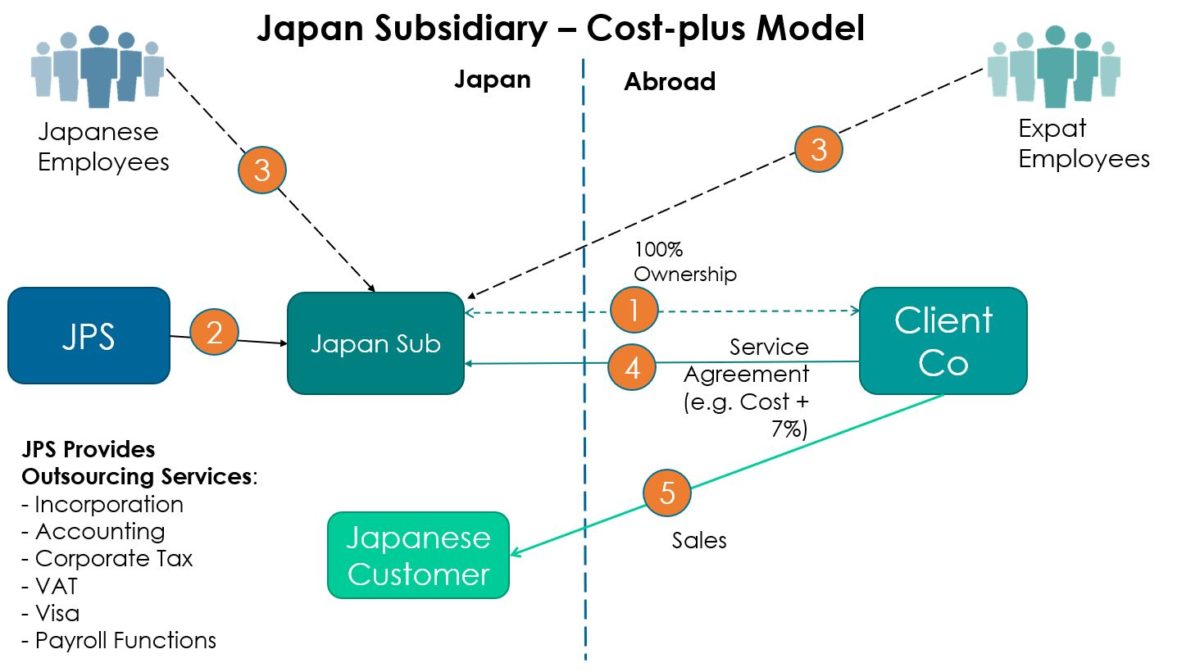Traditional Japan Subsidiary Using a Cost-Plus Structure
Possibly the most common tax / financial structure for a fully owned subsidiary in Japan is the cost-plus..
Establishing a fully owned subsidiary is the most traditional structuring option. Unlike a Japan PEO solution, all functions (tax, accounting, payroll, HR, etc.) are the responsibility of the subsidiary. JPS can assist by incorporating the new Japan entity and then providing outsourcing services to ensure the new subsidiary’s compliance with its tax, accounting, payroll, HR, obligations.

What is a Cost-Plus?
Cost-plus means that your Japan subsidiary has an agreement (usually with its foreign parent company) pursuant to which the Japan subsidiary will provide so called “sales support” services for the foreign parent in Japan.
Pursuant to this agreement, the parent agrees to reimburse the Japan subsidiary for its expenses PLUS a mark-up – mark-ups of 6% or 7% are common.
Under this arrangement, sales are made by the foreign parent company direct to Japanese customers. The foreign parent pays all of the Japan subsidiary’s expenses plus the percentage mark-up.
How it Works
JPS’s professionals will assist you to establish a fully owned Japan subsidiary. Most clients will choose either a Godo Kaisha (“GK”) or a Kabushiki Kaisha (“KK”). Visit our FAQ to learn more about choosing a Japan entity that will suit your needs.
An Outsourcing Support Agreement is put in place between the new Japan subsidiary and JPS. Following the incorporation of the new subsidiary, JPS will handle initial corporate tax filings and establish a corporate bank account. JPS will then provide ongoing accounting, tax, payroll, and HR support directly to your Japan subsidiary.
Employees (both foreign expats and locally hired employees) will be directly hired by your Japan subsidiary. JPS professionals will then assist with obtaining Japan work visas (if required) and setting up a Japan payroll. Japanese nationals and foreigners with existing Japan work visas can be immediately brought on board by your Japan subsidiary. Particular attention needs to be paid to Japanese social security (especially statutory health insurance) since uninterrupted coverage is the number one concern of Japanese employees.
This is an agreement put in place between the Japan subsidiary and the foreign parent company. This agreement specifies that the Japan subsidiary will provide (exclusively) “sales support” services for the foreign parent in Japan. The parent agrees to reimburse the Japan subsidiary for its expenses PLUS a mark-up – mark-ups of 6% or 7% are common.
Under this arrangement, sales are made by the foreign parent company direct to Japanese customers. The foreign parent pays all of the Japan subsidiary’s expenses plus the percentage mark-up.
Sales to Japanese customers are made directly between your company outside Japan and the Japanese customer.
Advantages of a Cost-Plus Subsidiary
Cost-Plus is probably the simplest tax / financial structure for a legal entity in Japan. Sales are recognized outside Japan, usually in the foreign parent company.
Disadvantages of a Cost-Plus Subsidiary
The activities that can be performed under a Cost-Plus arrangement are limited to sales support activities. Actual sales (defined broadly for Japanese corporate tax purposes) are not allowed. If the limited sales support activities are exceeded the foreign parent is exposed to permanent establishment (“PE”) tax risk.
